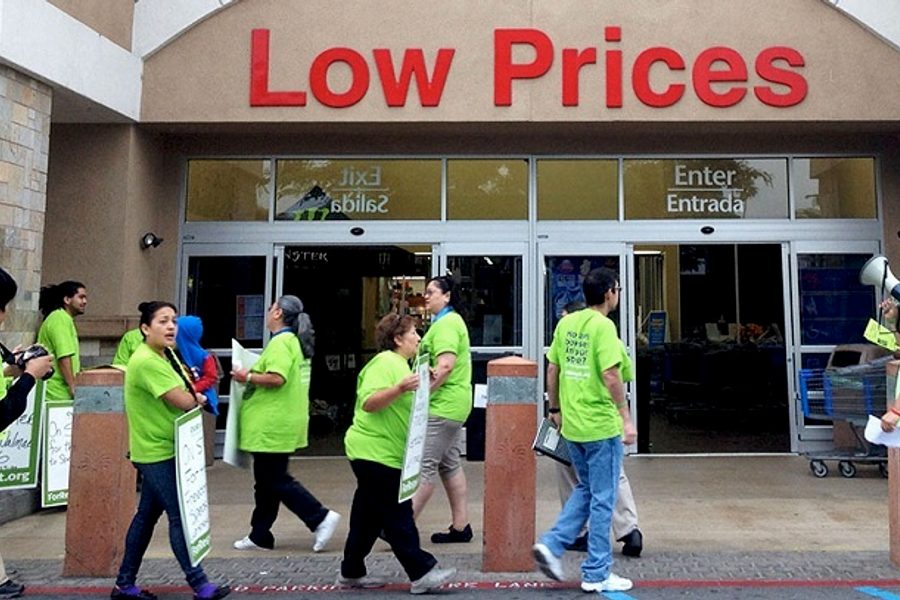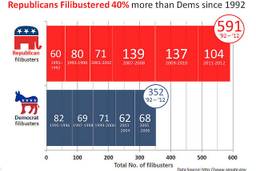Walmart’s Fishy Claim of 86 Percent Employee Satisfaction
Do Walmart’s high internal polling numbers reflect employee love--or fear?
John Logan

In an opinion piece in last week’s San Francisco Chronicle, Walmart West President Michael Bender states that, according to an internal survey conducted by management, 86 percent of the company’s employees “love their jobs.”
But just how reliable is Walmart’s internal polling on employee attitudes?
Walmart’s assertions are at odds with every national survey on employee satisfaction. In 2011, the Conference Board survey of U.S. households found that only 47 percent of Americans are satisfied with their jobs. Yet Walmart, which has some of the lowest wages and worst benefits of any large corporation in the country, has a satisfaction rate of 86 percent?
The company’s internal survey also conflicts with what outside sources have concluded about how much Walmart’s employees “love their jobs.” A Bloomberg Businessweek investigation in 2007 found that Walmart employee morale was “at rock bottom.” According to Businessweek, “many of Wal-Mart’s workers feel outright hostility toward the company, and, by extension, they often treat customers with indifference or worse.” Walmart competes almost entirely on the basis of low price, and this makes it virtually inevitable that employees are paid poverty wages and morale remains at “rock bottom.” According to one employee interviewed by Businessweek: “If Wal-Mart doesn’t care for me, why should I care?”
Help keep this reporting possible by making a donation today.
By all accounts, employee morale at Walmart has not improved since 2007. Earlier this year, Business Insider reported that, according to employees, working at Walmart “is worse than Target and Costco.” Based on a survey of 1,800 employees conducted by Glassdoor, a web forum sharing employment-related information, the Bentonville giant came dead last when it comes to its treatment of employees. On every major indicator of employee wellbeing — fairness and respect, employee morale, compensation and benefits, work/life balance, career opportunities and others — Walmart scored significantly lower than its major competitors. Employees also criticized Walmart CEO Mike Duke, who makes more money in one hour than many of his hourly-paid associates earn in an entire year. One manager-in-training at Walmart explained the problem as “putting profit first and people last.”Walmart employees may fear their managers, but they clearly do not “love their jobs.” And after last week’s revelation that the company intends to start denying health benefits to new associates working fewer than 30 hours per week — and shift the cost of their coverage onto taxpayers — it is unlikely that morale will improve anytime soon.
Workers in the factories that manufacture the company’s products overseas enjoy their jobs even less. When a horrific fire killed over 112 workers in Bangladesh earlier this month, it emerged that the factory was making garments for Walmart. Rather than accept its share of responsibility for these tragic events, however, Walmart denied knowing that the factory was still producing for it and insisted that this was the fault of a single sub-contractor, who had gone against the company’s wishes to stop using the factory. It now emerges that not one but three American suppliers were using five of the factory’s 14 production lines to manufacture for Walmart and its Sam’s Club subsidiary.
Not only were Walmart products made at the factory where 112 workers were burnt to death, the company played a central role in torpedoing efforts to improve factory safety in Bangladesh, which has been problematic for years. According to the New York Times, officials who attended a 2011 meeting on garment factories say that Walmart “played the lead role in halting an effort to have global retailers pay more for apparel to help Bangladesh factories improve their electrical and fire safety.” Protesting the plans to invest in safer factories which would have helped prevent life-threatening fires, but Walmart, which made $16 billion in profits last year, claims, “It is not financially feasible for the brands to make such investments.”
So Walmart not only impoverishes workers at home, it endangers them overseas.
Here’s a bold suggestion: if Bender is so confident that the overwhelming majority of their associates “love” their low-wage, dead-end jobs, why not allow employees to decide for themselves on the issue of unionization, without subjecting them to aggressive and illegal management interference? Why not call off the anti-union hit squads that are dispatched to stores across the country from Bentonville at the first indication of union activity? Why not stop the forced “captive audience meetings,” the one-on-one meetings with supervisors and the anti-union indoctrination that starts at the very moment that employees are first hired at the company? Why not refrain from the dozens of other legal and illegal anti-union tactics meticulously documented by the respected international organization, Human Rights Watch?
Given a free and uncoerced choice, Walmart “associates” would form unions in droves. Walmart management knows this, of course, and that is precisely why it is determined that they will never have that free choice. Behind the “love” expressed by 86 percent of employees in Walmart’s internal survey lies a deep fear.







